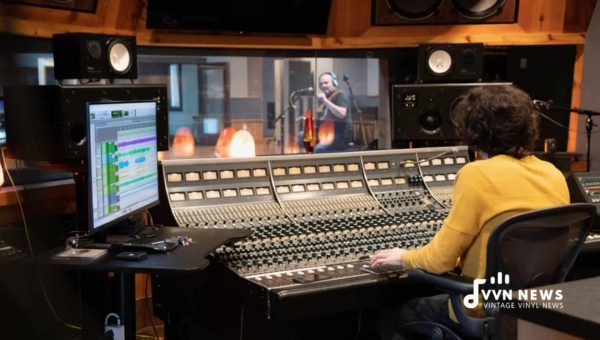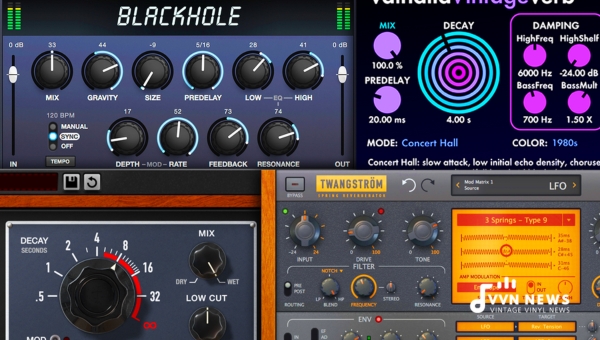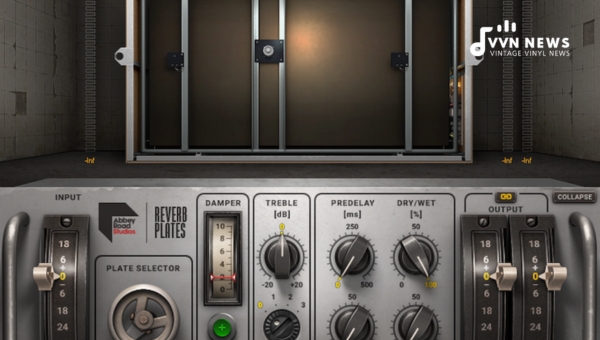Have you ever found yourself utterly mesmerized by the enveloping cosmic ambiance in your favorite record and wondered, “How do they get that sound?”
The secret often lies in an underexplored gem of audio technology: plate reverb. Once you see it, you will marvel at how integral it shapes the soundscape we adore.
The birth of plate reverb dates back to the golden era of recording, revolutionizing the industry with its distinct touch.
Its essence lies in mimicking real-life acoustics and conjuring a rich texture and depth that grants music a new dimension. Every sound enthusiast should delightfully delve into this world of aural magic.
What is Plate Reverb?
Plate Reverb is a type of artificial reverb that replicates the acoustics of different spaces and helps to add depth and warmth to sounds. It was initially developed in the late 1950s and early 1960s using large metal sheets or “plates.”
A transducer attached to the plate generated vibrations picked up by pickups, converted into an audio signal and mixed back with the original sound.
This technology played a significant role in shaping the sound of popular music from the ’60s through the ’80s.
Today, it is replicated digitally in audio production and recording software but still maintains its unique character, making it a favourite among music producers and engineers.
The History and Evolution of Plate Reverb

Before the advent of plate reverb, sound engineers needed to use physical rooms, known as echo chambers, to create reverb. This process was expensive, logistically challenging, and inflexible.
Everything changed in 1957 when a German company called Elektro-Mess-Technik (EMT) introduced the EMT 140, the first plate reverb unit.
The Original Plate Reverb Unit – EMT 140
The EMT 140, which weighs 600 pounds and is approximately the same size as a ping pong table, revolutionized audio production with its versatility and rich output. Instead of using a room’s natural acoustics, it employed a thin metal plate to generate reverb. The sound was sent through coils attached to the container via an amplifier. Two pickups captured various vibrations as the plate vibrated, creating unique reverberations.
Transition To Modern Day Music Production
The introduction of digital reverb units in the late 1970s marked another turning point. These digital devices emulated plates and various acoustic environments—from small rooms to large halls—at just a fraction of the physical space.
Despite this shift towards newer technologies, many producers and engineers still favor plate reverbs for their classic warm sound. Today’s technology allows these iconic sounds from our past to be housed in convenient plug-ins, offering plenty more creative control.
So, even in contemporary times, plate reverb continues its reign as an indispensable tool in music production.
Also Read: 20 Best Reverb Pedals For 2025 [Inject New Life Into Your Tone]
Types of Plate Reverbs
When it comes to plate reverbs, there are generally four broad categories that you may come across Natural, Artificial, Digital, and Mechanical.
Natural Plate Reverbs
A natural plate reverb is created when a sound wave physically hits a solid plate made of metal or glass. The vibrations created by the wave bouncing back from the plate create a unique reverb effect. This rugged and raw reverb is highly sought after for its distinct and warm tone. It’s a true testament to acoustics in their most basic form.
Natural plate reverbs were predominantly used in the 60s and 70s due to their warm tone,** but they are bulky and expensive**, making them less used today compared to artificial and digital alternatives.
Artificial Plate Reverbs
In contrast to natural plate reverbs, artificial types leverage digital technology or specialized software to create an echo-like effect. Actual plates don’t produce the sound; the software emulates the response you would typically get from an acoustic setup involving physical metallic plates.
Artificial reverbs give more flexibility than natural ones, as you can easily manipulate different parameters like decay time and coloration without worrying about physical constraints.
Digital Plate Reverbs
Digital plate reverb effects emerged with advancements in processing power. They are essentially digitized versions of artificial reverbs where considerable control over various aspects of the sound can be achieved through digital manipulation.
These reverb models have brought convenience to musicians who previously had to lug around large plates to achieve that cherished reverb effect. Today’s top-line digital plugins offer meticulous detail when emulating vintage sounds, with various features adjustable at the flick of a switch.
Mechanical Plate Reverbs
Last but not least are mechanical plate reverbs — these were devices specifically designed around vibrating metal plates as their core consumers of input signal energy. These devices induce motion in their thin steel armature when excited by audio signals passing through an electromechanical transducer assembly bonded onto them somewhere along their length.
Despite mechanical resonances being somewhat tricky to control—their sound was incredibly distinctive—giving mix engineers access to a wholly ‘other’ tonal palette within which they could work when required.
Also Read: Spring Reverb [Guide To This Special Audio Effect]
How Does Plate Reverb Work?

Here’s a bit of depth into how plate reverb functions. It works based on mechanical vibrations and some clever utilization of those vibrations to create reverberations.
Step 1: The Transducer in Action
When the audio signal is sent into the system, it hits an electromechanical transducer attached to a large, thin sheet of metal (the ‘plate’). It’s important to remember that a transducer is a device that converts variations in a physical quantity, like pressure or brightness, into an electrical signal.
Step 2: Creation of Vibrations
As the transducer vibrates, it sets off the plate into resonating. This starts with echoes bouncing across its surface – our much sought-after reverb.
Step 3: Capturing the Reverb
Contact microphones then capture the resulting waves on the other end of this lively ‘plate.’ These microphones transfer these reverberations back into an electrical signal.
Step 4: Control Parameters
In traditional plate reverb systems, specific control parameters manipulate this effect damping pad that can be moved closer or further from the plate to absorb vibrations and adjust the decay time selectively.
Remember, unpredictable aspects like varying temperature conditions or minuscule changes in the power supply can impact these vibrations and, by that measure, directly influence the nature of your resulting sound.
Also Read: 13 Types Of Reverb [Guide To Navigating The Soundscape]
How to use Plate Reverbs?
If you’ve got a basic handle on what plate reverb is, then it’s time to explore how it is utilized in music production. It works wonders across various applications, from drums and vocal tracks to virtually any audio source. Let’s dig deeper.
Drums
Using plate reverb on drums is an age-old practice, cherished especially for adding depth and richness. The trick lies in balance and restraint. When applied excessively, it may muddy up the mix and cause your kick or snare to lose their punch.
For brilliant results, you want just enough plate reverb on your drums that you notice its absence when muted but not so much that it overwhelms the drum sound. The EQ control is crucial here: rolling off the low end (usually below 600Hz) can help prevent muddiness while accentuating frequencies above 1kHz deliver that shiny sheen.
Adding Brightness
The alluring shimmer that comes with the application of plate reverb often serves as an excellent tool for adding brightness to your audio tracks without making them harsh or too prominent in the mix. It’s all about creating that “ethereal” vibe without dominating the overall sound character.
Want an instant sparkle? Adjusting the pre-delay parameter helps create a sense of space without washing out the original sound—a crucial factor for dealing with fast-tempo tracks or complex arrangements!
Vocals
A well-engineered plate reverb breathes life into dry vocal tracks, gracing them with an extraordinary spacious aura without drowning the lyrics in echo.
To get started, apply it on a separate auxiliary bus instead of directly inputting it into your vocal track—a widely preferred methodology for controlling wet/dry balance more seamlessly!
Try tampering with decay time settings to find just the right sweet spot—too short may sound artificial; too long could swamp the vocals. Aim for naturalism: pleasant spaciousness where words remain crystal clear even amidst depth-adding reverberation!
Best Plate Reverb Plugins in the Market

In this digital age, many plate reverb plugins offer astounding capabilities to emulate the cherished plate reverb effect. Each has its flavor, twang, and features that could add a whole new sonic palette to your productions. Let’s delve into seven of the most sought after and interesting offerings out there.
Kush Audio Goldplate
Kush Audio has made its name in creating some truly unique audio hardware and software over the years. Goldplate is their stab at a hybrid-style plate reverb that sets itself apart as it doesn’t just aim to emulate the characteristics of metallic plates. Instead, it embraces current plugin technology with features that allow you to blend plate and digital reverb styles.
Goldplate’s focus is on providing musical control over parameters. With characteristics like damping EQs to pitch modulation, it offers endless textural possibilities.
Also Read: What Is Reverb? [An In-Depth Guide For Audio Enthusiasts]
UAD EMT 140 Plate
Universal Audio’s EMT 140 Plate Reverb Plugin is modeled after three different original EMT 140 units from The Plant Studios in California for impeccable accuracy. There’s almost no reverb plugin list complete without something from UAD’s lineup, and for good reason.
The plugin beautifully captures the organic nature of mechanical plate reverbs while serving as a benchmark for modern-day reverbs aiming for a vintage sound. A joy to use, it renders any track its touches with an unmistakably lush classic vibe.
Soundtoys Little Plate
Unlike other plugins that load you with numerous controls, Soundtoys Little Plate’s simplicity makes it one of my favorites. It squashes complex parameters into just two (decay time and mix), allowing you even infinite decay times.
While minimalist at heart, Little Plate lacks none of the quality and charm we love about plate ‘verbs.
TAL Reverb 4
TAL’s plugins have often been valued for delivering superb quality on a budget, and TAL Reverb-4 is no exception. It’s incredibly affordable, but don’t let this fool you; value runs throughout this ambient-oriented early digital/plate hybrid reverberation plugin.
Despite not wholly focusing on plates, TAL Reverb 4 positions itself beyond others by offering the flexibility needed by composers wishing to drench their mixes in other-worldly tones – while keeping things minimalistic.
Arturia REV Plate-140
The Arturia REV PLATE-140, an homage to the classic EMT 140 hardware unit, delivers deceptively versatile tones with significant room for modification – powered by Arturia’s state-of-the-art modeling technology. Scroll through vintage plates or go adventurous with futuristic designs; a few doors are left unopened here.
Its voicing control provides tone coloring options while the echo filter adds retaining organic qualities, eliminating harshness when required.
Also Read: What Is Gated Reverb? 2025 [How To Create Gated Reverb Drums]
ValhallaDSP Plate
Lauded for remarkable value-for-money offerings, ValhallaDSP houses another fantastic gem within their lineup known as ValhallaPlate! From realistic plates to creative applications like flanging or chorus effects, it blends quality with affordability effortlessly!
This workhorse offers extensive parameter options and dedicates specific algorithms replicating various types of plate materials – resulting in capable hands pitching an exquisite soundscape variety!
Waves Abbey Road Plates
The synergy partnering between renowned plugin maker Waves and legendary Abbey Road Studio bore fruit in bringing us The Abbey Road Plates Plugin, their meticulous emulation single-handled handling of every aspect within four original plates still housed within Abbey Studio today.
Embracing both vintage allure and modern tweakability, this plugin surely warrants an audition!
There you have it – A rundown through seven outstanding places where passion meets creativity in various flavors! Dive right in and bring your sonic vision alive.
Let each track ring out with an ambiance as captivating as being brought alive through respective magical plates.
FAQs About Plate Reverb
What is the primary use of plate reverb in music?
Plate reverb is primarily used for adding depth and warmth to the sound while ensuring a unique texture that enhances its overall character.
Who introduced the concept of plate reverb?
It was first introduced by Elektro-Mess-Technik (EMT) in Germany in the late 1950s.
How does plate reverb differ from spring reverb?
While both are mechanical reverbs, spring reverb uses springs for creating echo, while plate reverb employs a large metal plate.
Is there any difference between real and digital plate reverb effects?
Yes, real plate reverbs utilize physical hardware including metal plates, whereas digital ones mimic these effects using software algorithms.
Can I use plate reverb in my home recordings?
Absolutely! There are numerous affordable plug-ins available that can add a professional-sounding plate reverb effect to your home recordings.
Conclusion
The magic of plate reverb lies in its ability to breathe life into music. It’s an incredible tool for musicians and sound engineers looking to introduce a vintage tint to modern productions without making them sound dated.
When used effectively, plate reverbs can add that elusive depth, shine, or character to your tracks.
They say language is the dress of thought; in the realm of sound production, you might find that plate reverbs are the attire of melodies.
The meticulous use of this effect could very well be the missing link to turn a good track into a timeless masterpiece.








